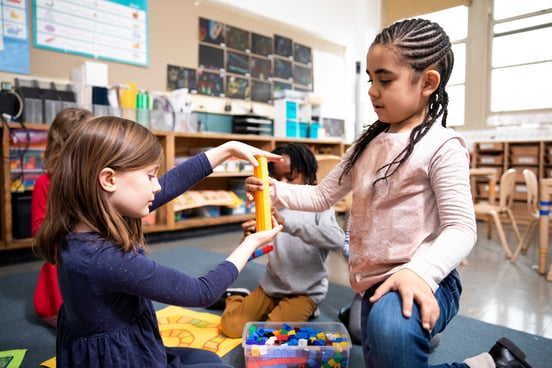
Math Assessment in California Schools: The Shift Toward Differentiated Instruction
Math assessment in California is changing. What used to be a compliance exercise or reporting tool is now becoming a...
ALI Staff | Published December 13, 2023
Formative assessment is a valuable tool that provides real-time insights into student understanding.
In theory, it can seem challenging to integrate when there are already so many moving pieces to consider with your students. In reality, you’re probably already using several different formative assessment types to adapt instruction and check on student progress.
These assessment tools are about empowering teachers to make decisions based on when students are ready to move on while boosting engagement along the way.

There are six different types of assessment in the classroom:
The top three are most common. Our focus here is on formative assessment types, an excellent way to see where students are with taught material and where a teacher needs to go next.
A formative assessment is an assessment that happens during the learning process. It provides ongoing feedback to guide instruction over the course of a lesson or unit of study.
For teachers, it’s helpful in measuring student progress and adjusting teaching strategies as needed.
For students, it’s a check for understanding.
Types of formative assessment include informal measures like peer reviews, student observations, and exit tickets.
When comparing formative assessments with summative assessments, think about the purpose of each.
Formative assessment offers immediate feedback to guide instruction. Summative assessment is an evaluation of student learning.
Formative assessment strategies are typically lower stakes than summative assessments.
Ideally, these are more informal approaches to gauge student learning and to better prepare students for that big exam or culminating project.
Teachers know their students best, and formative assessment tools that work best for one group of students may not be as effective with another.
Let’s take a closer look at formative assessment ideas in the classroom that might work with your students.
Common examples of formative assessment often include a pair or group component.
These are partner exercises where students think on a topic, discuss topics with a partner, and then share their thoughts with the whole group. It promotes active engagement, collaborative learning, and independent thinking.
Pairing students together allows them to refine their understanding before sharing with the class, building confidence along the way. It may also open students up to new ways of thinking.
These are an interactive way to gauge student understanding and give teachers immediate feedback after a new concept.
Teachers should make these low-stakes with lower point totals so students aren’t worried about how this will change their grade while still earning some easy points.
Shoot for higher-level questions with older kids to work critical thinking skills.
These sessions can be guided or open-ended. With older kids, try a Socratic seminar-style discussion to boost critical thinking skills.
While these are typically used in language arts classrooms, any new concept that requires heavy reading may benefit from a method where students facilitate the discussion.
For students who have a harder time participating in group discussions, incorporate methods like sticky notes on the board.
Students can put up their questions or what they’ve learned about a topic to guide discussion or even instruction on the following day.
In role-reversal scenarios, students take on the role of teacher to facilitate discussion.
Teachers can make this process less scary by trying this in smaller groups first.
Students can explain to their peers what they learned or address misconceptions or questions from their peers as they build confidence for larger group discussion.
Create opportunities for students to express themselves in a visual way.
Art-based assessments can include collages, scripts, or any physical representation of what students have learned.
Gallery walks, where students show off their work, can offer an added layer of peer assessment.
If you’re not sure where to start, simple concept mapping to show connections within a new concept is a visual way to check understanding for student groups at all levels.
Many formative assessment examples offer ways for students to reflect on their learning honestly.
Using student rubrics, have students grade themselves before turning in a culminating project.
Student rubrics should be the same rubric teachers use for a final grade, so there are no surprises. If they’re way off on their “grading,” that could be a teachable moment for instructors to address misconceptions.
Peer grading using student rubrics is a possibility, too.
Self-reflection journals allow students to reflect on their own learning as a lower-stakes form of self-assessment.
If students struggle with open-ended prompts, they can be guided to identify areas of strength or improvement related to the lesson or simply answer specific questions about a lesson.
Journals can be reviewed regularly or periodically. They can also supplement conversations at teacher conferences.
Schedule check-ins with students on at least a quarterly basis to evaluate individual progress.
This supports social-emotional learning, too, as it’s usually a more comfortable space for teachers to check in on skills like perseverance and self-advocacy.
It’s a great way to get to know students and their motivations to boost engagement down the line.
These quick responses are summaries of key concepts of the day or responses to a driving question before leaving class.
For teachers, it may guide instruction the following day and give an idea of areas of confusion or lingering questions.
Teachers can also use entry tickets to gauge where students are starting with a topic.
This may require some quick thinking if teacher assumptions about what students already know are too generous.
Interactive technology includes any virtual tools that gauge understanding.
This can mean online digital platforms that track and access student progress in real-time or responsive quizlets offering immediate feedback and adaptation for teachers and students.
A big plus of available technologies is how accessible it is for all students, including diverse learners.
If your focus is the science classroom, digital components of platforms like STEMscopes Science can dramatically improve student engagement and performance.
Formative assessment impacts learning by creating a more dynamic classroom environment. Teaching becomes more individualized and responsive to student needs.
Students receive immediate insights into their strengths and weaknesses to feel better prepared for summative assessments down the line.
Formative assessment in the classroom supports a deeper understanding of topics, particularly in STEM, and empowers teachers to tailor their approaches to their students.

Math assessment in California is changing. What used to be a compliance exercise or reporting tool is now becoming a...

You know the moment: a student’s eyes light up when the science experiment fizzes or the math puzzle helps them...

STEM classrooms are full of different types of learners in the classroom, each with their own strengths and needs.
...